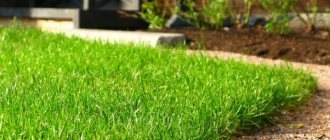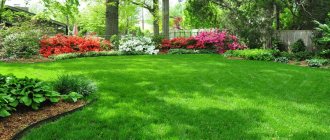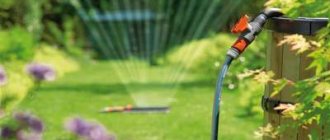Home — Lawn — Low-growing grass for an ideal lawn
A low-growing lawn is an excellent option for decorating a personal plot that does not require special care. A lawn covered with a soft green carpet will serve not only as decoration, but also as a pleasant place to relax. Properly selected herbaceous crops will ensure an attractive appearance of the site throughout the year.
An excellent solution is to create a dwarf lawn for the lazy.
Advantages and disadvantages of a dwarf lawn
Low-growing grass has a number of advantages:
- aesthetics - even in winter the coating retains its green color;
- high resistance to trampling and weather conditions;
- unpretentiousness to the composition of the soil;
- long period of existence - up to 30 years with proper care;
- resistance to pests and fungal diseases.
Among the disadvantages of low-growing grasses is the financial cost. A dwarf lawn, compared to other types, requires a larger amount of seed material. It is also important to choose the right composition of the herbal mixture. It should include thin-leaved, slow-growing crops. They will allow you to create a universal coating that does not require frequent mowing - “a lawn for the lazy.” It is enough to do this 3-4 times throughout the entire season. This is an ideal option for those who do not have the opportunity to devote a lot of time to caring for the site. For comparison, a lawn with tall grass has to be mowed several times a month.
Lawn grass that can be cut 3-4 times per season.
Types of lawn grasses
Let's look at the grasses most commonly used for dwarf coverings:
- Bentgrass is a bright green plant that retains its color throughout the summer. Its height does not exceed 12 cm. Gardeners are attracted by the ability of bentgrass to grow quickly. One plant covers an area of more than 1 m² with shoots in one season. The bentgrass bushes merge and form a continuous carpet. The grass tolerates trampling well.
- Clover is another popular perennial plant from the low-growing group. Beautiful pink and white spherical flowers give the lawn an original look. Clover's root system is very powerful, so it can be safely planted on steep slopes. Among the disadvantages, gardeners note the plant’s ability to absorb moisture, as a result of which after rain the lawn becomes very slippery and moving on it is dangerous.
- Meadow bluegrass. The plant remains green until late autumn. The lawn sown with it looks excellent for several years. The bushes grow extremely slowly, forming shoots underground, which creates a dense turf. Bluegrass loves water, so it needs to be watered often.
Meadow bluegrass grows quickly and survives the winter well.
- Simple red fescue is a low-growing grass that is especially popular among gardeners. The bushes cover the area evenly, giving the lawn the appearance of a fluffy green carpet. Prolonged drought has a detrimental effect on the plant.
- Hairy red fescue is the most suitable plant for a dwarf lawn. Long, stiff stems look like wire. Hairy fescue is resistant to temperature changes, drought, and unpretentious to the soil.
Low-growing lawn grasses are usually used for sowing in the form of a mixture in which the ratio of different plants is selected in such a way that the decorative characteristics of each are clearly expressed.
Maria Ivanovna, a summer resident from the Volgograd region, shares her impressions of the clover lawn:
“My daughter told me about this lawn. At first I didn't really want to. I thought it would look cheap. And they imprisoned me - and I didn’t regret it. That's so beautiful! The flowers are like white balls on a bright green blanket! Then they turn brown. Then we mowed them, and the meadow bloomed again. However, in wet weather our rug becomes too slippery and slugs appear on it. This is the only inconvenience."
What happens
In trade, seed material for growing lawns is presented in the form of a mixture of grasses. It is selected taking into account the purpose of using the lawn. The mixture contains herbs with the characteristics necessary for further use. In some cases, monograsses are used to grow lawns.
In total, there are 7 types of herbs used for these purposes:
- Tall lawn grasses (narrow ironweed, creeping wheatgrass, awnless bromegrass, vicoleaf sainfoin). The height of these herbs can reach more than 1 m. This group of plants is distinguished by its tallness, light-loving nature and thick stems. The advantages of grasses of this type include rapid growth, but the disadvantage is the need for frequent mowing. The grass has to be mowed several times a month.
- Semi-upland lawn grasses (yellow alfalfa, meadow timothy, perennial ryegrass). The group includes medium-sized lawn grasses. Their stems are 50-100 cm high. After cutting, the grasses very quickly come to life and grow, creating a dense lawn carpet. This type of plant is used for seeding large lawns. Herbs combine harmoniously with garden flowers.
- Medium-sized lawn grasses (red fescue, meadow bluegrass, bentgrass). The height of the plants included in the group can reach 50-70 cm. They are distinguished by thin stems and strong bushiness. The advantage of herbs of this type is their ease of care.
- Low-growing lawn grasses (white clover, periwinkle, thyme). Plants belonging to this group are used to create dense, low-growing grass carpets. They are characterized by slow growth. Despite this, lawns made from these grasses require frequent mowing. They also need regular watering. Herbs from this group are used to create lawns only in a mixture. To create a dense canvas, grass is cut to a height of 4-5 cm. The main disadvantage of plants is the high cost of seed.
- Rhizomatous lawn grasses (white bentgrass, bluegrass, meadow foxtail). A feature of plants of this type is the rapid growth of roots, which contributes to the formation of many new shoots. The grass carpets made from them are distinguished by their density, which is preserved for many years.
- Loose-bush lawn grasses (meadow fescue, wild grass, rhizomatous wheatgrass). This group of plants includes grasses with a shallow root system. They differ in that they have only one tillering node. Due to the spreading nature of the grass bushes, their lawns have good density.
- Tap-root lawn grasses (horned grass, blue alfalfa, red clover). The plants have lush bushes, are easy to care for, and look beautiful in a single carpet of lawns.
Classification of low-growing lawns
Depending on the grasses sown, the following types of low-growing lawns are distinguished:
- Clover. Several varieties of clover can be used simultaneously. In sunny weather this area looks especially beautiful. Considering that this plant is considered a weed, sow it away from vegetable beds.
Do you dream of walking barefoot on your own lawn?
- Lugovoy. The lawn is sown with a mixture of cereals and legumes. Various shades of colors look great against a green background.
- Mauritanian. The most colorful of all. Thanks to flowering plants, it can change color many times throughout the season. In addition to various herbs, poppies, cornflowers, and daisies are planted on the lawn.
- Parterre. A selected combination of grasses from red fescue, meadow grass and raygrass provides an unusually beautiful appearance of the lawn. Seeds are sown mainly in prominent places well lit by the sun. The ground lawn is finicky - it is very sensitive to lack of moisture and requires careful soil preparation. He has to be cut more often than others.
- Sports. It is characterized by rapid growth and high resistance to mechanical stress. The root system is perfectly formed. The grass mixture includes perennial raygrass, red fescue, meadow grass, timothy grass, taken in certain proportions.
There is another interesting type of lawn - rolled lawn. It is a layer of turf with overgrown grass. It is enough to spread such a roll on the site - and the lawn is ready. The grown grass takes root well, allowing you to easily and quickly fill the required area.
Rolls are a completely finished plant cover without weeds.
Popular wood mixtures
Assorted seeds of low-growing grasses are selected in accordance with the characteristics of the site. When choosing seeds, we recommend paying attention to the most popular grass mixtures among gardeners:
Moorish lawn
.
Ingredients: fescue, bluegrass, bentgrass, ryegrass, clover.
The seeding rate is 1 kg per 100 m².
Packing: paper bag weighing 1 kg.
The average price of one package is 650 rubles.
Lilliputian
Manufacturer: German company Agrolux.
Ingredients: 4 varieties of fescue, meadow bluegrass.
The seeding rate is 3.5 kg per 100 m².
Packaging: 8 kg, 2 kg and 0.5 kg.
The average price of each Lilliput package is 3600 rubles, 1000 rubles. and 300 rub. respectively.
Sports
.
Composition: mixture of fescue, meadow grass, ryegrass.
The seeding rate is 4 kg per 100 m².
Packing: branded bags of 20 kg.
The average price of one bag is 3,500 rubles.
Mini Grass
.
Ingredients: red fescue, meadow grass.
The seeding rate is from 2.5 to 4 kg per 100 m².
Packaging: 3.5, 7 and 20 kg.
The average price for 1 kg of Mini Grass is 450 rubles.
In arid regions, a special drought-resistant decorative mixture from Blooming Life is popular. Grasses with a deep root system help maintain the aesthetic appearance of the lawn even during prolonged drought.
Surina Olga Petrovna, 51 years old, (Penza region):
“The year before last we sowed the Mini Grass lawn mixture at our dacha. We can't be happier with how beautiful the site looks now! First we had to level it, prepare the soil (in general, the steps are simple - weeding, fertilizing and laying mulch), after which we began to plant the seeds by hand. The lawn started working immediately, in the first year the height was 8 cm before seasonal cutting, in the second - 10 cm. It looks great!”
It is not difficult to sow and grow lawn grass.
How to choose seeds: a few recommendations
When choosing grass for your lawn, you should follow a number of recommendations:
- It is necessary to pay attention to the expiration date of the seed. If the seeds are old, the germination rate will be low.
- It is important to understand what type of lawn you need (whether you are willing to mow the lawn often, whether you plan to walk on the lawn, whether the lawn will be located in the open sun or in the shade).
- Consider your region's climate because some lawn grasses only grow in warm regions.
- It is necessary to choose plants with the possibility of vegetative propagation.
We hope that our tips on which lawn grass is best have been helpful to you. It’s up to you to decide whether you will use a monoculture or a grass mixture, but you should always remember that even unpretentious plants require at least minimal care: periodic trimming, watering, and soil aeration.
Best time to seed your lawn
Herbal mixtures are frost-resistant and can be sown not only in spring and summer, but even in autumn. However, experts believe that it is best to plant lawn grass in the spring in order to be able to eliminate all the shortcomings during the season. By winter, the plants will get stronger and gain vitality.
Sowing in summer has its advantages - the soil is already well warmed up, weeds, as well as insect pests, lose their aggressiveness. Over the winter, the grass becomes resistant to disease.
Review from gardener G. I. Nesterov (Voronezh region):
“I sowed the Liliput variety in April. By August, a powerful carpet had formed, which is very pleasant to walk on barefoot.”
Grass sowing technology
Preparing the site involves clearing it of stones, stumps, bushes, and other objects that will interfere with the new lawn. The earth is carefully dug up, weeds are removed and the surface is leveled. Regardless of whether water stagnation occurs or not, a drainage system must be installed. Crushed stone, brick chips, and sand are suitable for its arrangement.
Before planting grass, fertilizers are added to the soil. You cannot sow on a freshly dug area. The soil must catch its breath, sit down. Weeds that appear during this time must be removed.
For planting seeds, choose a windless, dry day. Sowing is done manually or using a seeder to a depth of no more than 1.5 cm. This is done in a cross way - first in one direction, then crosswise.
To compact the soil above the seeds, you need to walk with a roller.
The seeded surface is carefully compacted and watered using the sprinkling method - the water is distributed to different heights and in different directions using a special watering gun. The next watering is carried out after the first shoots appear. It is important to correctly calculate the area of the lawn so as not to make a mistake and buy the right amount of seeds.
Tips for planting seeds
Sowing seeds yourself will allow you to get results only after 1-2 years, but considering that you only spend money on purchasing seed, this is a very good option.
Here are some tips to help you do everything right:
- Before sowing seeds, the area must be prepared. The area is leveled and slightly moistened.
- Sowing seeds can be done from the beginning of spring, when the frosts have subsided, until the fall. The only requirement is that the day must be cloudy, without wind. If you plant in the heat, a crust will form on the ground, which will slow down the germination of the seed.
- Seeds should be scattered evenly into the ground. You can do this manually, or prepare a device - a tin can or plastic bottle, in which you need to make holes for the appropriate size of seeds. You can buy a special seeder, which greatly simplifies the sowing process.
- You need to sow the seeds crosswise, going in two directions.
- When the seeds are sown, it is necessary to cover them with a thin layer of soil using a fan rake.
- Next, the soil needs to be compacted using a heavy metal roller.
- It is necessary to water the area regularly using a hose with a sprayer.
Good germination can be ensured with the help of covering material, which is used if there are a large number of birds around, as well as at temperatures below 15 degrees Celsius.











